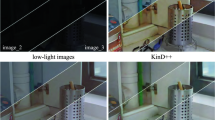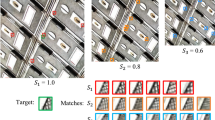Abstract
We address the tone reproduction problem by integrating the local adaptation effect with the consistency in global contrast impression. Many previous works on tone reproduction have focused on investigating the local adaptation mechanism of human eyes to compress high-dynamic-range (HDR) luminance into a displayable range. Nevertheless, while the realization of local adaptation properties is not theoretically defined, exaggerating such effects often leads to unnatural visual impression of global contrast. We propose to perceptually decompose the luminance into a small number of regions that sequentially encode the overall impression of an HDR image. A piecewise tone mapping can then be constructed to region-wise perform HDR compressions, using local mappings constrained by the estimated global perception. Indeed, in our approach, the region information is used not only to practically approximate the local properties of luminance, but more importantly to retain the global impression. Besides, it is worth mentioning that the proposed algorithm is efficient, and mostly does not require excessive parameter fine-tuning. Our experimental results and comparisons indicate that the described framework gives a good balance in both preserving local details and maintaining global perceptual impression of HDR scenes.
Similar content being viewed by others
References
Adelson, E.H. 2000. Lightness perception and lightness illusions. The New Cognitive Neurosciences, 2nd edition, pp. 339–351.
Aggarwal, M. and Ahuja, N. 2001. High dynamic range panoramic imaging. In Proc. Eighth Int’l Conf. Computer Vision, vol. 1, pp. 2–9.
Allred, S.R., Thompson, J.Y.S., and Jagadeesh, B. 2003. Color-based estimates of stimulus similarity predict perceptual similarity of image pairs to monkeys [abstract]. Journal of Vision, 3(9):511a.
Allred, S.R., Liu, Y., and Jagadeesh, B. 2004. Algorithms for image database navigation and tuning of object selective nneurons in the non-human primate. In APGV ’04: Proceedings of the 1st Symposium on Applied Perception in Graphics and Visualization, pp. 161–161.
Ashikhmin, M. 2002. A tone mapping algorithm for high contrast images. In 13th Eurographics Workshop on Rendering, pp. 145–156.
Barlow, H.B. 1961. The Coding of Sensory Messages: Current Problems in Animal Behaviour, W.H. Thorpe and O.L. Zangwill (Eds.), Cambridge University Press.
Bishop, C.M. 1995. Neural Networks for Pattern Recognition. Oxford University Press.
Canny, J.F. 1986. A computational approach to edge detection. IEEE Trans. Pattern Analysis and Machine Intelligence, 8(6):679–698.
Chiu, K., Herf, M., Shirley, P., Swamy, S., Wang, C., and Zimmerman, K. 1993. Spatially nonuniform scaling functions for high contrast images. In Graphics Interface, pp. 245–253.
Debevec, P.E. and Malik, J. 1997. Recovering high dynamic range radiance maps from photographs. In SIGGRAPH, pp. 369–378.
DiCarlo, J.M. and Wandell, B.A. 2000. Rendering high dynamic range images. In SPIE: Image Sensors, vol. 3965, pp. 392–401.
Durand, F. and Dorsey, J. 2002. Fast bilateral filtering for the display of high-dynamic-range images. In SIGGRAPH, pp. 257–266.
Fattal, R. Lischinski, D., and Werman, M. 2002. Gradient domain high dynamic range compression. In SIGGRAPH, pp. 249–256.
Ferwerda, J.A., Pattanaik, S., Shirley, P., and Greenberg, D.P. 1996. A model of visual adaptation for realistic image synthesis. In SIGGRAPH, pp. 249–258.
Gilchrist, A., Kossyfidis, C., Bonato, F., Agostini, T., Cataliotti, J., Li, X., Spehar, B., Annan, V., and Economou, E. 1999. An anchoring theory of lightness perception. Psychological Review, 106(4):795–834.
International Telecommunication Union (ITU). 1990. Basic parameter values for the HDTV standard for the studio and for international programme exchange. In ITU-R Recommendation BT.709, Geneva, Switzerland.
Jobson, D.J., Rahman, Z.U., and Woodell, G.A. 1997. A multiscale retinex for bridging the gap between color images and the human observation of scenes. IEEE Trans. IP: Special Issue on Color Processing, 6(7):965–976.
Kang, S.B., Uyttendaele, M., Winder, S., and Szeliski, R. 2003. High dynamic range video. In SIGGRAPH.
Kimmel, R., Elad, M., Shaked, D., Keshet, R., and Sobel, I. 2003. A variational framework for retinex. Int’l J. Computer Vision, 52(1):7–23.
Krawczyk, G., Mantiuk, R., Myszkowski, K., and Seidel, H.-P. 2004. Lightness perception inspired tone mapping. In Proc. Symp. Applied Perception in Graphics and Visualization, p. 172.
Land, E.H. and McCann, J.J. 1971. Lightness and retinex theory. J. Optical Society of America, 61:1–11.
Nayar, S.K. and Mitsunaga, T. 2000. High dynamic range imaging: Spatially varying pixel exposures. In Proc. Conf. Computer Vision and Pattern Recognition, vol. 1, pp. 472–479.
Palmer, S.E. 1999. Vision Science: Photons to Phenomenology. MIT Press.
Pattanaik, S.N., Ferwerda, J.A. Fairchild, M.D., and Greenberg, D.P. 1998. A multiscale model of adaptation and spatial vision for realistic image display. In SIGGRAPH, pp. 287–298.
Reinhard, E. Stark, M., Shirley, P., and Ferwerda, J. 2002. Photographic tone reproduction for digital images. In SIGGRAPH, pp. 267–276.
Rubner, Y. and Tomasi, C. 2001. Perceptual Metrics for Image Database Navigation. Springer.
Rubner, Y., Tomasi, C., and Guibas, L.J. 2000. The earth mover’s distance as a metric for image retrieval. Int’l J. Computer Vision, 40(2):99–121.
Schechner, Y.Y. and Nayar, S.K. 2003. Generalized mosaicing: High dynamic range in a wide field of view. Int’l J. Computer Vision, 53(3):245–267.
Schlick, C. 1994. Quantization techniques for visualization of high dynamic range pictures. In 5th Euro-graphics Workshop on Rendering, pp. 7–18.
Stokes, M., Anderson, M., Chandrasekar, S., and Motta, R. 1996. A standard default color space for the internet---sRGB. In http://www.w3.org/Graphics/Color/sRGB
Tomasi, C. and Manduchi, R. 1998. Bilateral filtering for gray and color images. In Proc. Sixth Int’l Conf. Computer Vision, pp. 839–846.
Tumblin, J., Hodgins, J.K., and Guenter, B.K. 1999. Two methods for display of high contrast images. ACM Trans. Graphics, 18(1):56–94.
Tumblin, J. and Rushmeier, H. 1993. Tone reproduction for computer generated images. IEEE Computer Graphics and Applications, 13(6):42–48.
Tumblin, J. and Turk, G. 1999. LCIS: A boundary hierarchy for detail-preserving contrast reduction. In SIGGRAPH, pp. 83–90.
Ward, G. 1991. Real pixels. Graphics Gems II, pp. 80–83.
Ward, G. 1994. A contrast-based scale factor for luminance display. Graphics Gems IV, pp. 412–421.
Ward, G., Rushmeier, H.E., and Piatko, C.D. 1997. A visibility matching tone reproduction operator for high dynamic range scenes. IEEE Trans. Visualization and Computer Graphics, 3(4):291–306.
Yee, Y.H. and Pattanaik, S.N. 2003. Segmentation and adaptive assimilation for detail-preserving display of high-dynamic range images. The Visual Computer, 19(7/8):457–466.
Author information
Authors and Affiliations
Corresponding author
Additional information
First online version published in October, 2005
Rights and permissions
About this article
Cite this article
Chen, HT., Liu, TL. & Fuh, CS. Tone Reproduction: A Perspective from Luminance-Driven Perceptual Grouping. Int J Comput Vision 65, 73–96 (2005). https://doi.org/10.1007/s11263-005-3846-z
Received:
Revised:
Accepted:
Published:
Issue Date:
DOI: https://doi.org/10.1007/s11263-005-3846-z




